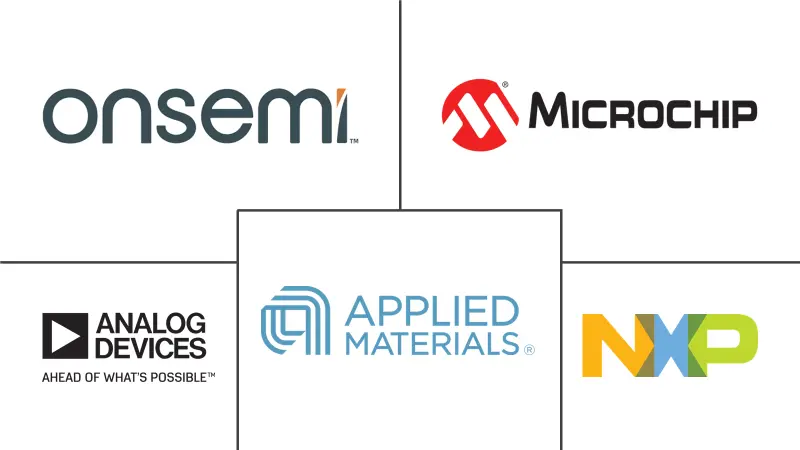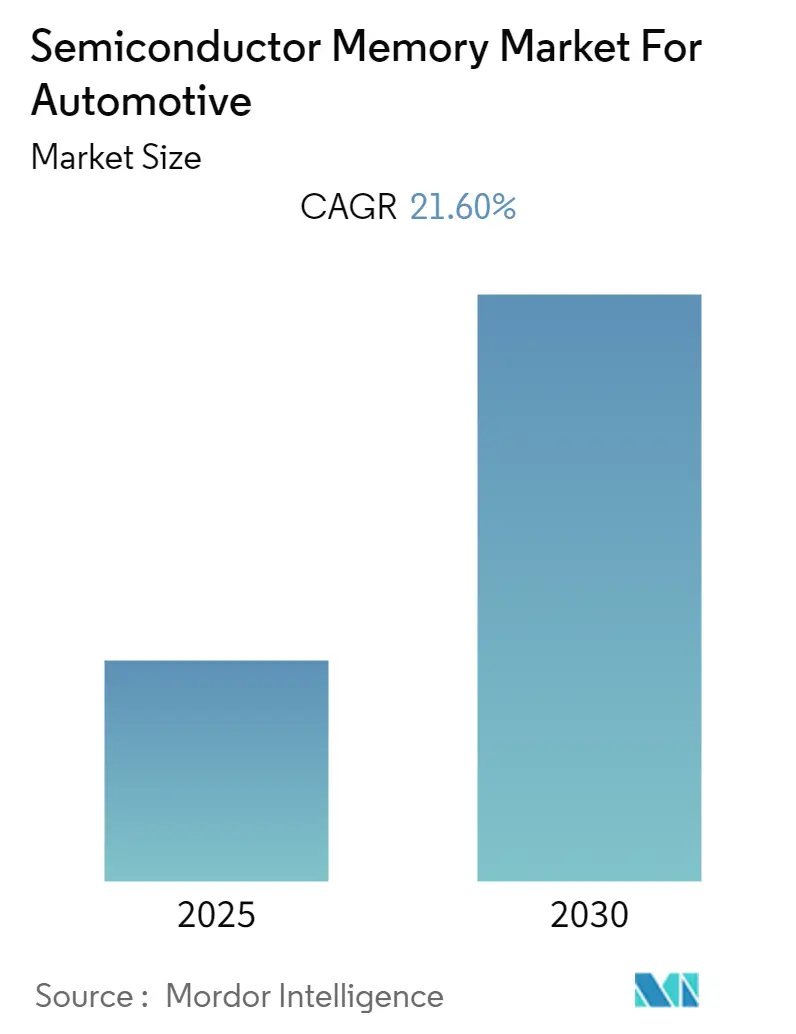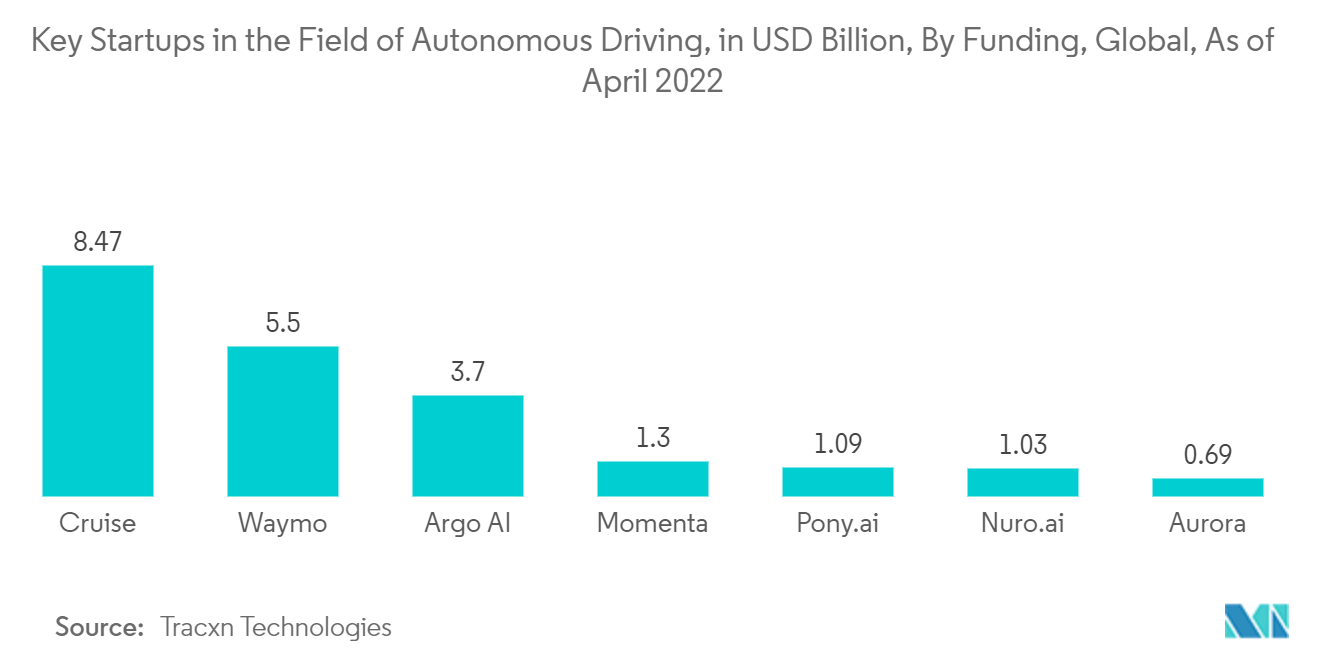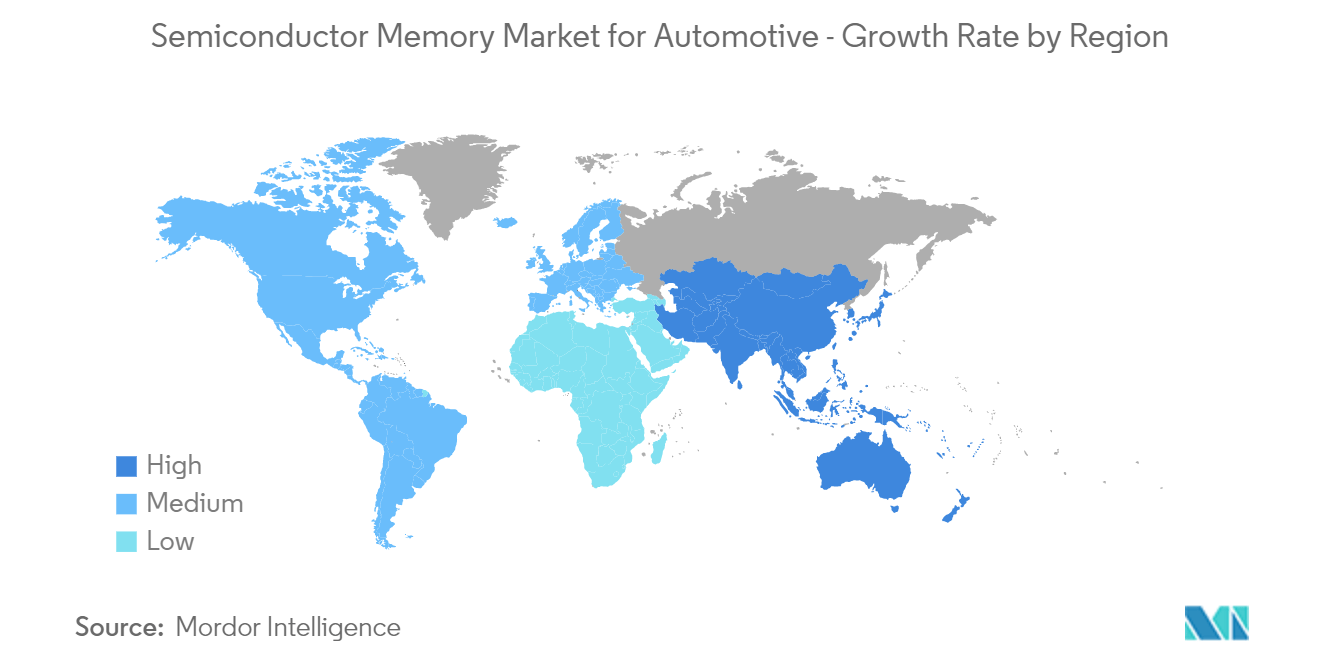Semiconductor Memory Market For Automotive Analysis
The Semiconductor Memory Market For Automotive Industry is expected to register a CAGR of 21.6% during the forecast period.
- The global market is expected to experience a surge in demand due to the widespread use of semiconductor components in various automotive applications. Over the past few years, the automobile industry has undergone a rapid transformation with the introduction of numerous advanced technologies, including 3D mapping applications, electric vehicles, and automation. As a result, there has been a growing need for several advanced semiconductor memory devices.
- According to the International Organization of Motor Vehicle Manufacturers (OICA), over 80 million automobiles were manufactured worldwide in 2021, representing a 3% increase from the previous year. Passenger automobiles accounted for 71% of total vehicle manufacturing, with 57 million units produced.
- The rising adoption of self-driving or autonomous vehicles is a crucial growth factor for the Advanced Driver Assistance Systems (ADAS) market, thereby driving the growth of the semiconductor memory market. For example, Intel estimates that global car sales will reach approximately 101.4 million units by 2030, and autonomous vehicles are expected to account for around 12% of car registrations by that year.
- The market is witnessing a growing demand for the development of advanced driver assistance systems (ADAS), which is expected to create growth opportunities for the market. In June 2022, Valeo and BMW Group entered into a partnership under which Valeo will provide the ADAS domain controller, sensors, and software for parking and maneuvering for BMW's next-generation modular 'Neue Klasse's platform for electric vehicles, which is set to launch in 2025.
- The COVID-19 pandemic resulted in changes in car-buyer behavior and customer attitudes. People today are more willing to accept digital services and features that allow them to stay connected, safe, and trackable. The increasing penetration of in-vehicle screens will facilitate the easy integration of many other digital features, such as virtual assistants, voice recognition, personalization, and gesture control. These developments are expected to fuel the demand for the semiconductor memory market.
Semiconductor Memory Market For Automotive Trends
ADAS to Hold a Significant Market Share
- The growing trend towards self-driving or autonomous vehicles is driving the expansion of advanced driver assistance systems (ADAS), as they have been shown to increase car safety and, in turn, enhance the safety of passengers. Studies have revealed that most car incidents occur due to human error, and ADAS technology can regulate, monitor, and decrease road fatalities.
- Governments around the world are taking measures to speed up the deployment of autonomous vehicles, which will fuel demand for ADAS. For instance, in November 2021, the UAE Cabinet approved a plan to test self-driving vehicles, making it the first Middle Eastern country and the second globally to test self-driving cars on its streets.
- The UK Government recently announced the launch of automated lane keeping system (ALKS) technology, which will help expedite the deployment of self-driving cars in the region. Designed for use in slow traffic, ALKS allows a vehicle to drive itself in a single lane while retaining the ability to return control to the driver when necessary.
- Moreover, the market is seeing the entry of several new players seeking to enter the rapidly expanding market. For example, in October 2022, Minda Corporation partnered with Korea's Daesung Eltec to design, validate, and set up a manufacturing line for ADAS systems for passenger vehicles, commercial vehicles, and off-road vehicles. Such advancements are expected to increase demand for the semiconductor market during the forecast period.
- Additionally, the increasing demand for autonomous vehicles is further driving the need for ADAS as they facilitate various levels of autonomous driving, depending on the installed features in the car. Furthermore, autonomous vehicle startups are attracting various funding sources, which will further boost market demand. According to Tracxn Technologies, as of April 2022, Cruise, the US autonomous vehicle company, was the most well-funded startup in the field of autonomous driving worldwide.
Asia-Pacific to Witness Significant Growth
- The Asia-Pacific semiconductor memory market for automotive is experiencing significant growth, fueled by increased automotive manufacturing and partnerships between various automotive original equipment manufacturers (OEMs) and semiconductor manufacturers. While fuel efficiency and cost used to be the most important factors for automobile buyers, now technology, safety, and luxury are becoming more significant.
- The growing demand for electric vehicles (EVs) is expected to further drive the expansion of the Asia-Pacific semiconductor memory market. To keep up with this demand, automobile manufacturers must continue to innovate and manufacture self-driving cars that have already attracted a significant number of customers in major automotive manufacturing countries.
- However, the growth trajectory of fully-autonomous and semi-autonomous automobiles will depend on several factors, including consumer willingness to accept fully-automated vehicles, technology advancements, pricing, and suppliers' and OEMs' capacity to address major concerns related to vehicle safety.
- China is a major contributor to the semiconductor memory market for automobiles in the Asia-Pacific region, owing to the increased use of safety features and infotainment applications like navigation. dvanced driver assistance systems (ADAS) have also grown in popularity in China, with features such as parking assist, forward collision warning, adaptive cruise control, blind-spot recognition, and lane-departure warning contributing significantly to the market's growth.
Semiconductor Memory Automotive Industry Overview
The semiconductor memory market for automotive is highly competitive due to an increase in the number of applications and technological advancements across regions. This provides lucrative opportunities in the market, but the overall competitive rivalry among competitors is high. To expand their market share, major vendors operating in the market adopt various strategic investments.
In June 2023, Applied Materials, Inc. announced its intention to build a collaborative engineering center in Bangalore, India, focused on the development and commercialization of technologies for semiconductor manufacturing equipment; the center will be designed to bring together applied engineers, leading global and domestic suppliers, and top research and academic institutions, enabling The common aim of this collaboration is to promote the development of subsystems and components for semiconductors equipment in one place.
In May 2023, NXP Semiconductors announced its collaboration with TSMC to deliver the industry’s first automotive-embedded MRAM (Magnetic Random Access Memory) in 16 nm FinFET technology. Automakers must support multiple generations of software upgrades on the same hardware platform, as they move towards a Software Defined VehicleSDV.
Overall, strategic investments are key to expanding market share and staying competitive in the Semiconductor Memory market for Automotive. Vendors must continue to invest in research and development to stay ahead of the curve and provide innovative solutions to meet the ever-evolving demands of the market.
Semiconductor Memory Market For Automotive Leaders
-
Analog Devices, Inc.
-
Applied Materials, Inc.
-
MicrochipTechnologies Inc
-
NXP Semiconductors N.V.
-
Semiconductor Components Industries, LLC
- *Disclaimer: Major Players sorted in no particular order
Semiconductor Memory Market For Automotive News
- September 2023 - GlobalFoundries and Microchip Technology collaborated and announced the release to production of the SST ESF3 third-generation embedded SuperFlash technology NVM solution in the GF 28SLPe foundry process, where customers are finding this combination of high performance, excellent reliability, IP availability and cost-effectiveness to be ideal for advanced MCUs, complex smart cards and IoT chips for consumer and industrial products
- July 2023 - Applied Materials, Inc has announced introduced materials, technologies, and systems that help chipmakers integrate chiplets into advanced 2.5D and 3D packages using hybrid bonding and through-silicon vias (TSVs). The new solutions extend Applied’s industry-leading breadth of technologies for heterogeneous integration (HI).
Semiconductor Memory Automotive Industry Segmentation
Semiconductor memory is an electronic semiconductor device used to store data digitally. It refers to metal-oxide-semiconductor (MOS) memory, where data is stored in the MOS memory cells on a silicon-integrated circuit memory chip.
The semiconductor memory market for automotive is segmented by technology (code storage, working memory, and data storage), memory (DRAM, NAND Flash, and NOR Flash), application (ADAS and AD and digital cockpit), and geography (North America, Europe, Asia-Pacific, the Rest of the World). The market sizes and forecasts are provided in terms of value (USD) for all the above segments.
| By Technology | Code Storage |
| Working Memory | |
| Data Storage | |
| Other Technologies | |
| By Memory | DRAM |
| NAND Flash | |
| NOR Flash | |
| By Application | ADAS and AD |
| Digital Cockpit | |
| Other Applications (Powertrain, Chassis & Safety, Body & Comfort) | |
| By Geography | North America |
| Europe | |
| Asia-Pacific | |
| Rest of the World |
Semiconductor Memory Market For Automotive Market Research Faqs
What is the current Semiconductor Memory Market for Automotive Industry size?
The Semiconductor Memory Market for Automotive Industry is projected to register a CAGR of 21.60% during the forecast period (2025-2030)
Who are the key players in Semiconductor Memory Market for Automotive Industry?
Analog Devices, Inc., Applied Materials, Inc., MicrochipTechnologies Inc, NXP Semiconductors N.V. and Semiconductor Components Industries, LLC are the major companies operating in the Semiconductor Memory Market for Automotive Industry.
Which is the fastest growing region in Semiconductor Memory Market for Automotive Industry?
Asia-Pacific is estimated to grow at the highest CAGR over the forecast period (2025-2030).
Which region has the biggest share in Semiconductor Memory Market for Automotive Industry?
In 2025, the North America accounts for the largest market share in Semiconductor Memory Market for Automotive Industry.
What years does this Semiconductor Memory Market for Automotive Industry cover?
The report covers the Semiconductor Memory Market for Automotive Industry historical market size for years: 2019, 2020, 2021, 2022, 2023 and 2024. The report also forecasts the Semiconductor Memory Market for Automotive Industry size for years: 2025, 2026, 2027, 2028, 2029 and 2030.
Our Best Selling Reports
Semiconductor Memory For Automotive Industry Report
Statistics for the 2025 Semiconductor Memory For Automotive market share, size and revenue growth rate, created by Mordor Intelligence™ Industry Reports. Semiconductor Memory For Automotive analysis includes a market forecast outlook for 2025 to 2030 and historical overview. Get a sample of this industry analysis as a free report PDF download.







